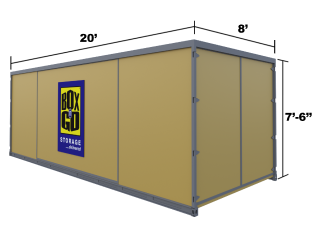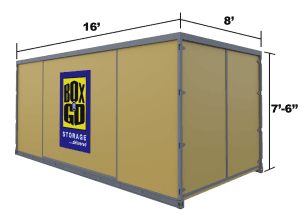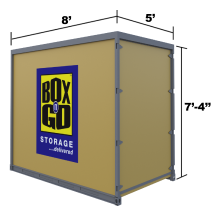


REVIEWS
RATING
GUARANTEE
Store on your driveway or inside our secure facility. Load/unload only once. Ground level access.


20’ Container – all weather.
Perfect for 3-bedroom residence.
5-7 rooms, furniture, appliances, etc.

16’ Container – all weather.
Perfect for 2-bedroom residence.
3-5 rooms, furniture, appliances, etc.

8’ Container – all weather.
Modular – works for any need.
Each fits 1-1.5 rooms.



- No truck to rent. We deliver storage to you!
- Load/Unload only once.
- Pay only for space you use.
- Secure, climate-friendly facility.
- Drive-up access
- Save money and time.
- Reduce the risk of accidents and injuries.
- No need to pay for gas, insurance & mileage!
- You only need to load your belongings once!
- No need to load and unload it all again into a storage unit.
- All containers come with easy ground level access!
(if storing at our facility)
- No not need to guess on how much space you actually need.
- Order an extra 8’ x 5’ unit. Do not use it – do not pay for it.
- Highest degree of security and protection.
- Our 8’ x 5’ units are breatheable – no mold or mildew.
- No funky smell when your belongings return.
(if storing at our facility)
- Access your units at ground level.
- No elevators, ramps, stairs to climb.
- Schedule access appointment & drive straight to your units.

How To Pack Your Kitchen for a Move or Storage
You can begin packing your kitchen for storage and moving almost immediately by starting with your less-used serving dishes, seasonal items and small appliances. Next, tackle your large serving bowls, tablecloths and specialty pots and pans. Keep your everyday dishes for last. You may even want to consider buying some disposable plates, cups and utensils for those last few nights when everything is packed away.
Food Items:
Use or dispose of all perishables. You will also need to get rid of cleaning products and other kitchen chemicals. See our listing of prohibited items for further details. Boxed or canned goods should be packed in small boxes. Dispose of any open packages and wrap glass jars to prevent breakage.
Dishes and Glassware:
Place a layer of packing inside the bottom and at the top of boxes containing glassware. All glass items should be individually wrapped. Nest cups and bowls and stand plates and saucers and platters on edge. Consider using potholders and dishtowels to cushion the bottom and sides of your boxes. Wrapped glasses should be placed near the top of cartons. Fine silver should be wrapped in cloth or silver paper. Fill all pockets with packing. Always make sure you have plenty of cushioning below and above all your glassware. For greater protection, consider purchasing “dish packs.” Make sure your boxes are firmly packed so they will not be crushed. Label boxes containing glassware “FRAGILE – THIS SIDE UP” and do not place heavy items on top of boxes with glassware.
Flat China & Flat Glassware:
Larger china and glass plates, platters and other flat pieces are excellent as the lowest layer in a dish pack. Place cushioning material in the bottom of a carton. Wrap each piece individually with clean paper, then wrap up to three in a bundle with a double layer of newsprint. Place these bundled items in the carton in a row on edge. Surround each bundle with crushed paper, being careful to leave no voids or unfilled spaces. Add two or three inches of wadded paper on top of the bundle to protect rims and make a level base for the next tier. Horizontal cardboard dividers can be helpful in keeping layers level. Smaller plates, saucers and shallow bowls could make up a second layer. Wrap and pack in the same way as larger items. Label boxes containing glassware “FRAGILE – THIS SIDE UP” and do not place heavy items on top of boxes with glassware.
Bowls and Odd-shaped Items:
Depending on their weight, these might be used for either the bottom or middle layers. Wrap the same way as flat plates. Stand shallow bowls (soup plates, etc.) on edge in the carton and deeper ones (such as mixing bowls) nested two or three together, upside down on their rims. Wrap sugar bowl lids in newsprint, turning them upside down on top of bowls. Then, wrap both together in newsprint, followed by a double outer layer. Wrap sugar bowls, cream pitchers, sauce containers, gravy boats and similar pieces in newsprint and then a double outer wrapping. Place all upright in the carton, then top off the layer with wadded newsprint. Label boxes “FRAGILE – THIS SIDE UP” and do not place heavy items on top.
Cups: Even when using a dish pack and cellular dividers, wrap china cups individually first, protecting handles with an extra layer of clean paper. Then, pack cups upside down. If not using cellular dividers, wrap cups individually first in a double layer of paper and place them upside down on rims in a row on an upper layer with all handles facing the same direction. Top off the layer with wadded newsprint. Label boxes “FRAGILE – THIS SIDE UP” and do not place heavy items on top.
Pots & Pans:
Pots, pans and similar items should be wrapped and packed in medium size cartons. Depending on their weight, these might be used for either the bottom or middle layers.
Silver & Flatware:
To protect silver pieces from tarnishing, they should be completely enclosed in newsprint or plastic wrap. Hollow ware, including bowls, tea sets and serving dishes should be wrapped carefully like fragile items and packed like china. Loose flatware may be wrapped individually or in sets, and in paper, clear plastic bags or small gift boxes that are then secured with tape. Even if silverware is in a chest, consider wrapping the pieces individually and repositioning them in the chest. Or, fill all voids in the chest with newsprint to prevent shifting. The chest can be wrapped in a large bath towel.
Figurines and Other Delicate Items:
Be sure the items are well-protected with plenty of cushioning. Wrap first in tissue paper, paper towels or facial tissue. Then, wrap carefully in paper that has been wadded and flattened out. Small mirrors, plaques and pictures should be wrapped individually in tissue paper with an outer layer of newsprint. A bath towel or small blanket makes an excellent outer wrapping and padding for glass. Place items on edge in a carton.
Small Appliances:
In preparing your appliances for packing and storage, it is important that they be clean and dry to avoid the build up of mildew and mold and do not attract rodents. Items such as clocks, small radios and other small appliances should be wrapped individually and packed in a carton cushioned with crushed paper. If their cords disconnect, wrap them in plastic and secure them to the appliance they belong to. Make sure cords are wrapped so as not to scratch or damage items. Steam irons should be emptied of all water, wrapped and placed in the cushioned bottom of a box.
TIP: Remember to turn off and unplug any appliances before you start preparing and cleaning them for packing.
Cookbooks:
Pack books of the same general size together, in small book cartons for easy lifting. Pack them either flat, or with the spine touching the bottom of the carton. Do not pack with spine facing upward, as glue can break away from the binder. Do not place boxes directly on concrete floors, but use pallets or skids to prevent moisture absorption. Use packing to fill out empty pockets in the boxes. Do not pack fragile items in the same box with books and do not overload. These boxes will get heavy quickly so remember to use your legs when lifting. Do not pack boxes heavier than 50 pounds. Expensively bound volumes or those of sentimental value should be individually wrapped before packing. We advise against packing such items for storage or moving inside the containers.

